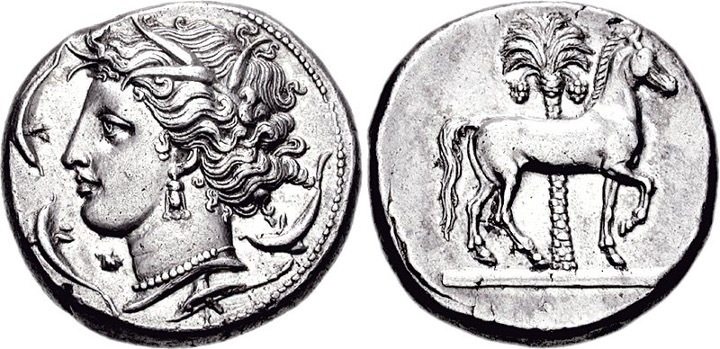2629 - Siculo-Punic (tetradrachm Persephone/horse) over uncertain type (Triton, 10, Jan. 2007, 64)
From SILVER
350 BCE - 315 BCE
Location/history
| Sale(s)Sale(s) ᵖ: | Triton, 10, 09 Jan. 2007, 64. | |
Overstriking coin
Description
| ObverseInscription or printing placed on the obverse.: | Head of Persephone or Arethusa left, wearing earring, necklace and barley-ear wreath. Below chin, shell. Around, 4 dolphins. Border of dots. | ReverseInscription or printing placed on the reverse.: | Horse standing right, palm tree behind. |
Mint and issuing power
| MintIdentifies the place of manufacture or issue of a numismatic object.: | Siculo-Punic (uncertain mint) | Ancient regionAncient region. | Sicily | Modern countryModern country: Italy | AuthorityIdentifies the issuing power. The authority can be "pretended" when the name or the portrait of X is on the coin but he/she was not the issuing power. It can also be "uncertain" when there is no mention of X on the coin but he/she was the issuing power according to the historical sources: | Carthaginian Empire |
Chronology
| FromIdentifies the initial date in a range assigned in a numismatic context. 350 BCE toIdentifies the final date in a range assigned in a numismatic context.. 315 BCE | Classical 480-323 BC |
Physical description
| MetalThe physical material (usually metal) from which an object is made.: Silver |
WeightWeight of the numismatic object (in grams). in grams: 16.8316.83 g <br />16,830 mg <br /> | DenominationTerm indicating the value of a numismatic object. Examples: tetradrachm, chalkous, denarius.: tetradrachm |
AxisDescribes the directional relationship between the obverse and reverse of a numismatic object.: 44 mm <br />0.4 cm <br /> |
| StandardStandard.: Attic | |||
References
| Coin referenceReference of the Coin: | Coin series referenceReference to coin series study: | Jenkins 19771Jenkins 1977, n° 133-4, Jenkins 19972Jenkins 1997, 134 (O45/R120’)., HGC 23HGC 2, n° 282 |
Overstruck type
Description
| ObverseInscription or printing placed on the obverse.: | Head ? (visible on reverse) | ReverseInscription or printing placed on the reverse.: |
Mint and issuing power
| MintIdentifies the place of manufacture or issue of a numismatic object. ᵖ: | Ancient regionAncient region. ᵖ | Modern countryModern country: | AuthorityIdentifies the authority in whose name (explicitly or implicitly) a numismatic object was issued. ᵖ: |
Chronology
| FromIdentifies the initial date in a range assigned in a numismatic context. toIdentifies the final date in a range assigned in a numismatic context.. | periodTime period of the numismatic object. |
Physical description
| DenominationTerm indicating the value of a numismatic object. Examples: tetradrachm, chalkous, denarius. ᵖ: | tetradrachm |
References
| Coin type referenceReference to coin series study ᵖ: |
Additional data
| Frequency of overstrikesFrequency of overstrikes: | Level of confidenceLevel of confidence of the identification: | ||
| RemarksRemarks: | |||
References
- ^ Jenkins, Gilbert Kenneth (1977), "Coins of Punic Sicily. Part 3. Carthage Series 2-4", Schweizerische numismatische Rundschau, 56, p. 5-65, pl. 1-22.
- ^ Jenkins, Gilbert Kenneth (1997), Coins of Punic Sicily, Zurich, Schweizerische Numismatische Gesellschaft.
- ^ Hoover, Oliver D. (2012), The Handbook of Greek Coinage Series. 2. Handbook of the Coins of Sicily (Including Lipara). Civic, Royal, Siculo-Punic, and Romano-Sicilian Issues. Sixth to First Centuries BC, Lancaster-London, 489 p.
